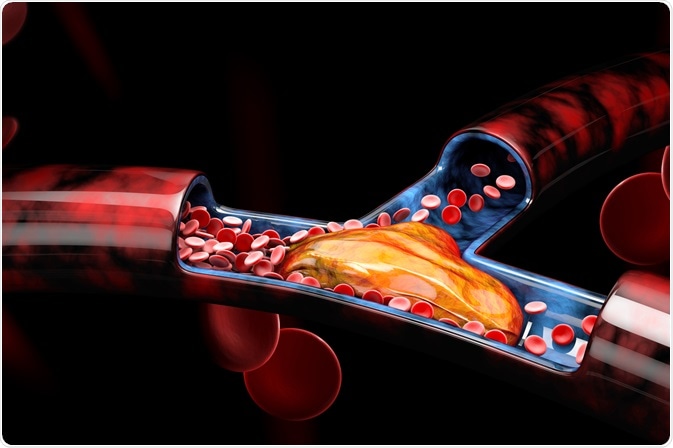A thrombus is a blood clot that can be formed in the circulation system and obstruct the flow of blood, which often occurs in areas affected by atherosclerotic plaques.
When the thrombus breaks free, it is known as an embolus and can travel around the bloodstream to other areas of the body and cause serious complications, such as pulmonary embolism and stroke. Although blood clots are the most common cause of embolization, any foreign body or air bubble in the bloodstream may cause similar effects.

Image Credit: Victor Josan / Shutterstock
What is thrombosis embolization?
Thrombosis embolization is the process of a blood clot detaching from the area of the bloodstream where it coagulated and grew to obstruct the vessel.
The blood clot that moves around the bloodstream is called an embolus, which can become lodged in other areas of the body. Cell tissue death can occur and result in serious consequences when the embolus obstructs the flow of blood to essential organs such as the heart, lungs or brain.
Pathogenesis
Thrombosis usually occurs as a result of natural coagulation factors present in the blood that are needed to stop the flow of blood if the blood vessel ruptures. Some health conditions cause these coagulation factors to create blood clots when there is no bleeding, which can obstruct blood flow.
Health conditions that are likely to lead to thrombosis include:
- Obesity
- Cardiovascular disease
- Cancer
- Pregnancy
Deep vein thrombosis is the most common cause of pulmonary embolism in the lung, which involves the formation of a blood clot in the deep vein of the thigh or hip. People with a family history of this disease are more susceptible to pulmonary embolism and should take preventative measures to keep the blood flow moving, such as moving the legs during long sedentary periods.
The process of a blood clot breaking free to become an embolus appears to happen spontaneously, and anyone with thrombosis may experience embolization and the resulting effects.
Symptoms and Complications
In most cases, there are not any immediate symptoms that are indicative of the presence of an embolus in the bloodstream. There may be some associated swelling in the area of the blood clot formation. However, when the embolus lodges in a blood vessel and obstructs the flow of blood to an essential organ the effects quickly become obvious.
This is because continuous blood flow is essential to supply oxygen to all the cells in the body and without oxygen, the tissue begins to die. This commonly occurs in the lungs and may cause symptoms such as:
- Dyspnea
- Arrhythmia
- Chest pain
- Cough
If these symptoms are noted, treatment should be sought as soon as possible.
Treatment
The treatment of thrombosis embolization depends on the size and location of the embolus in the body, as this will affect which tissues are likely to be affected and the appropriate management.
Anticoagulant medications are usually the first-line choice of medication to treat thrombus embolism, which works by dissolving the blood clots and preventing the formation of more or larger clots forming. Heparin is often used in a clinical situation to dissolve the clot, along with warfarin or aspirin on a long-term basis as a method of prevention.
Embolectomy is a surgical procedure sometimes used to remove an embolus in the bloodstream, which usually involves an incision into the affected artery and removal of the clot with an aspiration technique.
Prevention
Although the absolute prevention of thrombosis embolization is not possible, there are several methods that may be adopted to reduce the risk of an individual.
Nutrition plays an essential role, particularly as obesity is one of the strongest risk factors for the condition. The best food choices are low in fat, sugar and salt but high in fiber, with a large intake of fruit and vegetables. Lifestyle can also make a significant difference and individuals should be encouraged to quit smoking and partake in regular exercise.
Individuals susceptible to deep vein thrombosis, such as those with a family history of the condition or who have previously suffered from it, should take care to avoid staying sedentary for long periods of time. Particularly during long periods of travel on an airplane or bed rest, it is important that regular movements of the legs and feet are made to keep the flow of blood moving. Additionally, compression stockings can help to prevent the formation of clots.
References
Last Updated: Apr 23, 2021